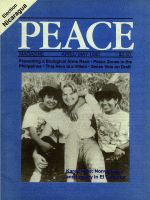
Peace Magazine Apr-May 1990, page 23. Some rights reserved.
Search for other articles by Dean Babst here
Search for other articles by Patricia Axelrod here
The air is full of electronic emissions by radar and radio waves, telecommunications, static electricity, and lightning--which cause explosions!
By Dean Babst and Patricia Axelrod
LIGHTNING AND RADAR can accidentally launch missiles, explode bombs and crash aircraft. You have seen signs along the highway that say, "Danger-Blasting Zone-Turn off Two-Way Radios."
Your radio waves can trigger nearby blasting caps and dynamite. Likewise, rockets can be unintentionally exploded by electromagnetic radiation generated by radio waves, TV, high tension power lines, electrical generators, and static electricity.
Military people have been con-cerned for a long time how the Haz-ards of Electromagnetic Radiation to Ordnance (HERO) can result in accidental detonation of warheads and unplanned launching of missiles. Of the many suspected accidents triggered by electromagnetic radiation, a few examples follow.
These incidents are part of a long series of similar accidents when black powder explosions were caused by electrostatic sources: the USS Pennsyl-vania in 1944, LST 999 in 1945, ihe USS Colorado in 1945, the USS South Dakota in 1945, and a naval ammuni-tion depot at Seal Beach, California in 1946, the USS St. Paul in 1952, and the USS Newport News in 1972.
THERE IS increasing concern in British and West German Parliaments. The Observer Scotland (Aug. 6, 1989) said, "Growing evidence that military weapons and aircraft in the U.K. may be susceptible to a new and frightening hazard-which could cause them to lose control, fall from the sky, or even detonate-is likely to cause particular concern in areas of Scotland with a concentration of military bases.
"The problem is caused by electronic smog, a random, invisible cloud of electromagnetic radiation that blankets the world and is thought to inter-fere with the guidance and control systems of many sophisticated weapons and aircraft. Like other pollutants, it is largely man-made, the product of hundreds of radio emitters, from radars to power lines to long-distance telephone relays, augmented by a few natural sources such as lightning."
The Electronic Engineering Times of Aug. 8, 1988 said, within the next ten years, more than 60% of the components in electronic de-vices will probably be sensitive to very low voltage. The process of making extremely small electronic parts is increasing the susceptibility of weapon components to electrostatic discharge dangers.
If a military base is located near you, you should ask:
The space shuttle Challenger trag-edy and the Chernobyl nuclear plant meltdown are reminders of the cost of large accidents. As nuclear weapons become more complex, the likelihood of catastrophic accidents increases. By sharing information on weapon acci-dents we can help increase nations' desire for arms reduction agreements. U
Patricia Axelrod is with the Richardson Peace Research Institute, University of Lancaster, England and Director of The HERO Project. Dean Babst is Coordinator of Accidental War Studies for the NuclearAge Peace Foundation. A more extensive HERO report ts available from the Nuclear Age Peace Foundation, 1187 Coast Village Rd, # 123, Santa Barbara, CA.

Peace Magazine Apr-May 1990, page 23. Some rights reserved.
Search for other articles by Dean Babst here
Search for other articles by Patricia Axelrod here